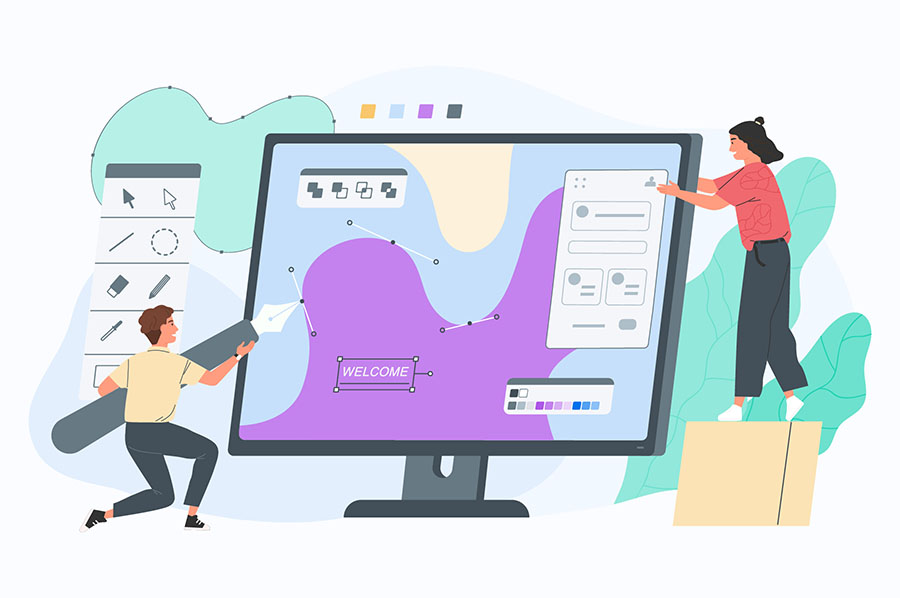A Comprehensive Guide to Crafting Visually Appealing and Functionally Robust Web Design Solutions
A comprehensive understanding of foundational style concepts, together with an eager focus on individual experience, can significantly improve the performance of web options. By leveraging components such as color concept and responsive layouts, developers are geared up to develop not just aesthetically pleasing interfaces however also ones that cultivate user engagement.
Understanding Design Concepts
Understanding design principles is basic to producing effective web options that involve customers and connect messages plainly. These concepts function as the foundation for any type of effective layout job, guiding the aesthetic and useful facets of a site. Key design principles include balance, contrast, positioning, repeating, and distance, each playing a vital duty in developing a natural and cosmetically pleasing format.
Contrast boosts readability and draws attention to crucial functions, permitting users to navigate the material easily. Repetition strengthens a consistent visual language, reinforcing brand name identity and enhancing individual experience with the interface.
Value of User Experience
Individual experience (UX) is critical in web style, as it directly influences exactly how site visitors connect with a site and perceive its value. A well-designed site not only draws in individuals however likewise keeps them engaged, eventually causing higher conversion rates and consumer complete satisfaction. UX incorporates various elements, consisting of functionality, availability, and the general aesthetic charm of the site.

Furthermore, positive individual experiences foster brand loyalty and motivate repeat sees. Inevitably, focusing on customer experience in internet layout is crucial for producing useful, interesting, and effective web sites that satisfy the needs of contemporary individuals.
Color Theory in Website Design
Shade concept plays an essential function in website design, influencing not just the aesthetic charm of a site yet additionally the psychological actions of its individuals. Comprehending color dynamics is crucial for developing an efficient user experience. Shades can stimulate particular sensations; as an example, blue commonly communicates trust and professionalism and trust, while red can impart excitement or necessity.
When choosing a color palette, designers ought to consider harmony and comparison. Complementary colors can produce vibrancy, while comparable shades provide a more calm feel. Using devices like shade wheels can aid in recognizing effective shade combinations. In addition, access should be focused on; guaranteeing enough comparison between text and history shades is important for readability.
Additionally, cultural context plays a significant role in color analysis. For circumstances, while white represents purity in Western societies, it may represent mourning in some Eastern societies - web design. An extensive understanding of the audience is crucial when applying color theory.
Incorporating color psychology into website design not only improves aesthetic charm however additionally affects customer habits, assisting them toward wanted activities. Inevitably, a well-balanced shade method can dramatically boost the general effect of a web site.
Receptive and Flexible Designs
In addition to color concept, the framework and format of a web site significantly impact customer Read Full Article experience and involvement. web design. Receptive and adaptive layouts are crucial approaches for making certain that internet sites work effectively throughout a plethora of tools and screen sizes
Receptive layout utilizes fluid grids and adaptable images, permitting the design to readjust flawlessly according to the viewport dimensions. This method ensures a regular user experience, as material reflows and resizes, maintaining access whether seen on a smart device, tablet, or desktop. Media queries play an essential role in receptive layout by applying various designs based on the this contact form gadget's attributes.

Both methods aim to enhance user experience by prioritizing use and access. Selecting between responsive and flexible designs largely depends on job demands, target audience, and wanted individual interactions, ultimately adding to the efficiency of website design remedies.
Screening and Optimization Techniques
Examining and optimization methods are vital components of reliable web design, making certain that internet sites not only fulfill individual assumptions however also do efficiently throughout different platforms. These techniques include a range of methods focused on examining usability, performance, and overall efficiency.
A/B screening is a fundamental strategy, allowing developers to compare browse around this web-site two variations of a websites to figure out which carries out better in terms of individual involvement and conversion prices. Customer testing is just as essential; it includes gathering responses from actual individuals to recognize pain points and areas for enhancement. This qualitative information can lead layout changes that boost individual experience.
Additionally, performance optimization strategies such as picture compression, code minification, and leveraging internet browser caching can considerably boost load times and responsiveness. Tools like Google PageSpeed Insights and GTmetrix give valuable metrics for evaluating internet site efficiency, making it possible for developers to make data-driven decisions.
Final Thought
Receptive designs add to a smooth customer experience across gadgets, further promoting engagement. Eventually, the application of these strategies not just elevates individual complete satisfaction yet also drives conversion prices, strengthening the importance of a thorough design framework.